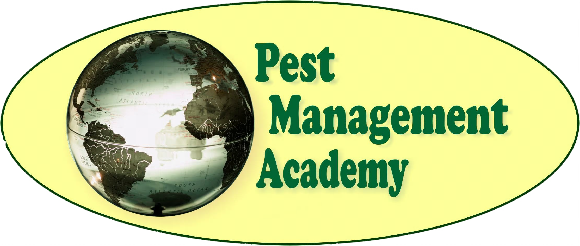


NETHERLANDS 0031 20 369 0282 | EUROPE 0037 28 154 8353 info@pestmanagementacademy.eu


NETHERLANDS +31(0)611143443

1.2.1 Introduction to Weed Control
1.2.2 Legislation
1.2.3 The Biology of Weeds
1.2.4. Herbicides
1.2.5 General Protection of Plants and Plant Products Information
1.2.6 Control of Woody Plants
1.2.7 Management of Aquatic Weeds
1.2.8 Weed Management in Turfgrass
1.2.9 Equipment and Calibration
1.2.10 Safety and Environmental Aspects
1.2.11 Weed Photo Gallery
SECTION 2 LEARNING MAP
SECTION 3 LEARNING DESCRIPTION AND OUTCOMES
SECTION 4 DEFINITION AND CLASSIFICATION OF PESTICIDES IN TERMS OF TYPE AND GROUPING
4.1 Introduction
4.2 The Classification Code
4.2.1 Pesticide Labels
4.3 Pesticide Classification, Properties and Products
4.3.1 Classification according to Target Pest
4.3.2 Classification, Properties and Products
SECTION 5: INTRODUCTION TO WEED CONTROL
5.1.1 Weeds and invader plants
5.2 What is a weed?
5.2.1 Definition of a Weed
5.2.2 The Difference between Alien Invasive Plants and Environmental Weeds
5.2.3 What Does Protection of Plants and Plant Products Entail?
5.2.4 The Place of Weeds and Problem Plants in Nature
SECTION 6: LEGISLATION
6.1 Relevant Legislation
6.1.1 The Fertilisers, Farm feeds, Agricultural Remedies and Stock Remedies Act, 1947 (ACT No. 36 of 1947)
6.1.2 Legislation on Declared Weeds and Invaders
6.1.3 The Conservation of Agricultural Resources ACT, 1983 (ACT No. 43 of 1983) (CARA)
6.1.4 The National Water ACT, 1998 (ACT No.36 of 1998) (NWA)
6.1.5 The Environmental Conservation ACT, 1989 (ACT 73 of 1989) (ECA)
SECTION 7: INTRODUCTION TO THE OCCUPATIONAL HEALTH AND SAFETY ACT NO. 85 OF 1993
7.1 Introduction
7.2 Exploring Key Concepts
7.3 Regulatory and Enforcement Policies
7.4 Understanding the Responsibilities of all Involved
7.4.1 The Business Owner or Chief Executive Officer as the Employer
7.4.2 Line Management (Supervisors) as Representatives of the Employer
7.4.3 Section 8. General duties of employers to their employees
7.4.4 Duties or Responsibilities of Employees
7.4.5 General Duties of Employees at Work
7.4.6 Duties or Responsibilities of Health and Safety Representative Structures
7.5 Health and Safety Committees
7.6 Moving Beyond Duties and Responsibilities
7.6.1 Company Values and Health and Safety
7.7 Safe Work Practices
7.7.1 Work Safely
7.7.2 General Chemical Safety Guidelines
7.7.3 Flammables
7.7.4 Spill Response
7.7.5 Safe Storage Practices
7.7.6 Hazardous waste - Think Twice Before You Dump It
7.7.7 Mind Your Back
7.8 Conclusion
SECTION 8: THE BIOLOGY OF WEEDS
8.1 Classification of Weeds
8.1.1 Weed Categories
8.1.2 Distribution of Weeds
8.2 Invasive Status
8.2.1 Environmental Weeds
8.2.2 List of Prohibited and Regulated Plants per Category
8.2.3 Guide to the Identification of the Species
SECTION 9: HERBICIDES
9.1 Introduction
9.2 Classification of Herbicides
9.2.1 Non-selective versus selective
9.2.2 Mobility within the plant: Systemic herbicides
9.2.3 Time of application
9.2.4 Long versus short residual
9.2.5 Mode of Action
9.2.6 Herbicide Combinations
9.2.7 Formulations
9.3 Herbicides used in industrial Weed Control
9.3.1 Organic-arsenic Compounds
9.3.2 Phenoxy Compounds
9.3.3 Phosphonic Acids
The Basic Protection of Plants and Plant Products skills program has been developed to enable the pest control operator to become proficient in Protection of Plants and Plant Products procedures. This skills program has been designed to be used in commercial, industrial and road shoulders, railway lines, substation environments and water programs.
The Basic Protection of Plants and Plant Products skills program deals with the following elements:
- Inspection Procedures
- Identification of Weeds and Declared invaders
- Selection of Herbicides / Weed Killers
- Selection and Calibration of Equipment
- Safety Precautions
- Application Techniques
- Monitoring Procedures
- Clean up Procedures
The Basic Protection of Plants and Plant Products skills program starts with a three day practical induction course in a classroom environment after which the student is assessed and on being found competent a six month mentoring program must be completed.
The following is included in the course:
- Refreshments.
- Full comprehensive manual.
- Practical assessment
PROTECTION OF PLANTS AND PLANT PRODUCTS PROGRAM (EQF 4)
9.3.4 Pyridene Carbolic Acid Compounds
9.3.5 Pyriloxy Compounds
9.3.6 Triazines
9.3.7 Uracils
9.3.8 Urea Compounds
9.4 Herbicide Resistance
9.4.1 What is Herbicide Resistance?
9.4.2 Selection pressure
9.4.3 Resistance mechanisms
9.4.4 Factors influencing the development of resistance
9.4.5 Herbicide rate and the development of resistance: does rate really matter?
SECTION 10: GENERAL Protection of Plants and Plant Products INFORMATION
10.1 Introduction
10.1.1 What is Control?
10.2 Problem plants
10.2.1 Bush encroachers
10.2.2 Pioneer plants
10.2.3 Invasive alien plants
10.2.4 Declared Invader plants
10.2.5 Problems caused by invasive alien terrestrial plants
10.2.6 Problems caused by invasive alien aquatic weeds
10.3 What you need to know about weed control
10.3.1 Control of Weeds and invasive plants
10.3.2 Who will administrate this legislation, and how will it be enforced?
10.3.3 Why control weeds?
10.3.4 Protection of Plants and Plant Products methods
10.3.5 The biological basis of weed control:
10.3.6 Selectivity of Herbicides
10.4 Methods of Control
10.4.1 Mechanical control
10.4.2 Chemical control
10.4.3 Biological weed control
10.4.4 Soil-applied Herbicides
10.4.5 Foliar-applied Herbicides
SECTION 11: CONTROL OF WOODY PLANTS
11.1 Mechanical Control
11.1.1 Situations
11.1.2 Techniques used in mechanical control
11.1.3 Advantages of mechanical control
11.1.4 Disadvantages of mechanical control
11.2 Cultural Control
11.2.1 Situations
11.3 Chemical Control
11.3.1 Situations
11.3.2 Advantages of chemical control
11.3.3 Disadvantages of chemical control
11.4 Biological Control
11.4.1 How biological control works
11.4.2 Situations
11.4.3 Advantages of biological control
11.4.4 Disadvantages of biological control
11.5 Integrated Control
11.5.1 Impacts
11.5.2 Scope
11.6 Utilisation
11.6.1 Scope
11.6.2 Advantages of utilisation
11.6.3 Disadvantages of utilisation
11.7 Use of Fire
11.8 Application Techniques of Woody Weeds
11.8.1 Introduction
11.8.2 Foliar Application
11.8.3 Stem and Stump Application
11.8.4 Soil-applied Herbicides
SECTION 12: MANAGEMENT OF AQUATIC WEEDS
12.1 Introduction
12.2 Negative impacts
12.3 Control
12.3.1 Mechanical control
12.3.2 Chemical control
12.3.3 Biological Control
12.4 Control of Water hyacinth in South Africa
12.4.1 Introduction
12.4.2 Economic, ecological and social impacts
12.4.3 Approaches to management
12.4.4 Physical and mechanical control
12.4.5 Chemical control
12.4.6 Biological control
12.4.7 Challenges to effective control of water hyacinth in South Africa
12.4.8 Potential for successful control through an IPM approach
12.5 Control of Water Lettuce in South Africa
12.5.1 Introduction
12.5.2 Description
12.5.3 Distribution
12.5.4 Origin of water lettuce
12.5.5 Biology
12.5.6 Reproduction
12.5.7 Control of water lettuce
12.6 Control of Kariba weed (Salvinia molesta)
12.6.1 Description of Kariba weed
12.6.2 Key points
12.6.3 How it spreads
12.6.4 Where it grows
12.6.5 Controlling salvinia
12.6.6 Herbicide application
12.6.7 Other management strategies
12.7 Control of Parrot feather (Myriophyllum aquaticum)
12.7.1 Description and Variation
12.7.2 Economic Importance
12.7.3 Habitat
12.7.4 History
12.7.5 Growth and Development
12.7.6 Reproduction
12.7.7 Response to Herbicides
12.7.8 Response to Mechanical Methods
12.7.9 Biocontrol Potentials
12.8 Control of Red water fern - Azolla filiculoides Lam.
12.8.1 Introduction
12.8.2 Biology
12.8.3 Negative impacts
12.8.4 Control Methods
SECTION 13: WEED MANAGEMENT IN TURFGRASS
13.1 Introduction
13.2 Weed Identification
13.3 Weed invasion
13.4 Weed Management before Planting
13.4.1 Prepare Your Site
13.4.2 Select an appropriate turfgrass species
13.5 Weed Management in newly planted lawns
13.6 Weed management in established Lawns
13.6.1 Cultural/mechanical Practices
13.6.2 Chemical Weed Control
13.7 Renovating Lawns
13.8 Alphabetical List – Declared Weeds and Invader Plants
SECTION 14: EQUIPMENT AND CALIBRATION
14.1 General
14.1.1 Important Factors
14.1.2 Principles of Calibration
14.1.3 Equipment and Calibration for industrial weed control
SECTION 15: SAFETY AND ENVIRONMENTAL ASPECTS
15.1 Introduction
15.1.1 Environmental Safety
15.1.2 Environmental Impact
SECTION 16: WEEDS PHOTO GALLERY: INDEX
SECTION 17: SAFETY ON THE JOB
17.1 Safe Handling Procedures and Practices
17.2 Safety in Relation to Pest Control Activities
17.2.1 Safe Handling of Pesticides
17.2.2 Toxicity of Pesticides
17.3 Handling Pesticides
17.3.1 Signals, warnings and safe handling directions
17.3.2 Routes of exposure to Pesticide Poisoning
17.3.3 Poisoning hazard
17.4 Personal protective equipment and clothing
17.4.1 Protective equipment
17.4.2 Personal Protective Clothing (SABS 072: 1993)
17.4.3 Keys and Tips to Safe Handling
17.5 Handling of Spillages
17.5.1 What to do When a Spill Occurs?
17.5.2 Clean-up Procedures
17.5.3 Decontamination Procedure
17.5.4 Disposal
17.5.5 Personal Hygiene
17.6 Triple rinsing
17.6.1 Why triple rinse?
17.6.2 How to “Triple Rinse” Empty Containers:
17.7 Pesticide Poisoning First-Aid Procedures
17.7.1 In the Event of Accidental Poisoning
17.7.2 General principles of first aid
17.7.3 Step-by-step CPR instructions
17.7.4 Be Prepared – Take Precautions
17.8 Pollution and the Environmental Impact
17.8.1 Pollution
17.8.2 Pollution through Drift
17.9 The Environment
17.9.1 Poisoning of Animals
17.9.2 Damage to Plants
17.9.3 Contaminated Food
SECTION 18: TOPIC 2 SAFE STORAGE PROCEDURES AND PRACTICES
18.1 Introduction to Pesticide Storage
18.1.1 Important Safety Factors
18.1.2 Household Items
18.1.3 Security Measures
18.1.4 The Pesticide Storing Facility
Dates Venue Cost
Training Information
Course Content
|
TBA |
Amsterdam 3 Days 09:00-16:00 |
TBA |